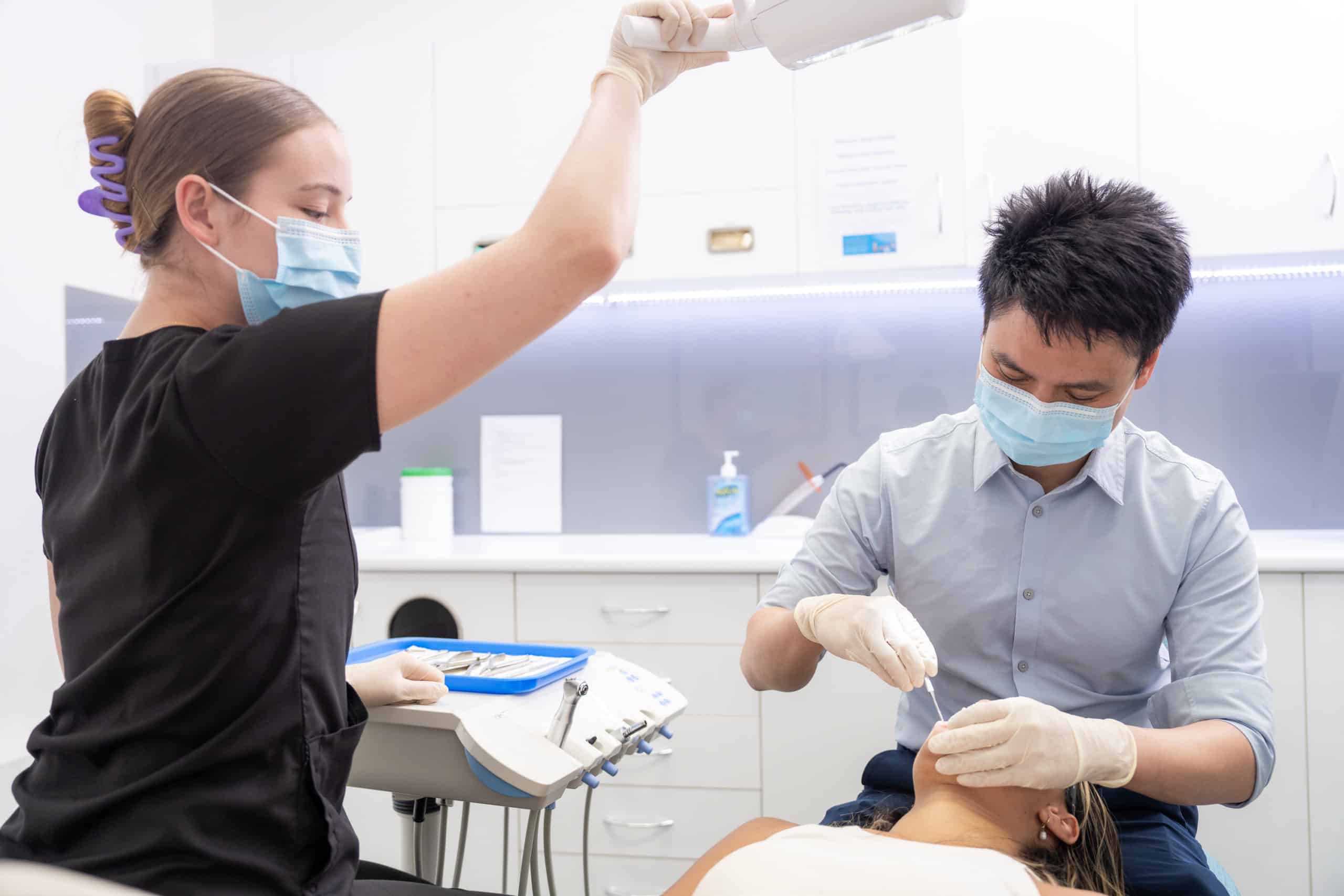
Orthodontics
Does age affect orthodontic treatment?
You can have orthodontic treatment at any age but treatment tends to take longer as we get older. While many patients come to us as teenagers, there is an increasing trend for people in their 30s and 40s (and beyond) to have treatment to ensure their natural teeth last and look great later in life.
Do I need a referral from my dentist to see an orthodontist?
No, there’s no need for a referral – simply phone ethos for an appointment. Of course, your dentist might be the person who discovers a problem and suggests you visit an orthodontist. If you haven’t seen your dentist for six months, your orthodontist may ask you to have a check up before treatment begins.
Will the orthodontist remove teeth?
No, your ethos orthodontist will always try to design a treatment that does not involve removing any teeth. If it is essential to remove a tooth, the orthodontist will refer you to a dentist for the removal.
Is orthodontic treatment painful?
Having braces or a retainer device fitted doesn’t hurt. However, sometimes you may notice some discomfort in the first few days after fitting and adjustment as your teeth start to move to a new position. You can take paracetamol or ibuprofen if you need to.
How long does the treatment take?
It all depends on your teeth and treatment plan. The orthodontist will give you an estimate but treatment may take a little longer for some people. Your orthodontist will also give you clear instructions for wearing and maintaining your appliance, which will help the treatment work as quickly as possible.
Will I need more treatment in the years ahead?
Teeth continue to shift throughout life but the change usually slows down after your early 20s. To help prevent your teeth moving, we will fit you with a high-quality titanium alloy retainer that will keep your teeth in place. Your orthodontist and oral health therapist will make sure you get all the information you need to care properly for your new smile.
What will happen when my wisdom teeth come through?
Wisdom teeth do not contribute to the crowding of lower incisor teeth. The main reason to remove wisdom teeth is if the gums around them are infected or inflamed.
Are there any risks to orthodontic treatment?
Normally orthodontic treatment is straightforward and leads to a very successful result. As with any sort of medical or dental treatment, in rare cases, things don’t quite go according to plan, or there may be a complication. Ask your orthodontist about the risks and how best to avoid them.
At what ages should my child see an orthodontic specialist?
The ideal age to review your child’s teeth is between 8-10 years old. Orthodontists can monitor growth and development and intervene when necessary.
Who needs orthodontics?
Do you have teeth that grind or clench? Or jaws that click? Perhaps you’re having difficulty with speech, or problems chewing and biting. These are all conditions that an orthodontist can help with.
Many people will need to see an orthodontist at some stage in life. Perhaps because of a problem that’s developed in adulthood. Or one that was not treated properly when they were younger.
treatment for all ages and life stages
While many adults want to achieve a straight, natural smile through orthodontics, there are often dental health reasons too. Proper alignment reduces wear and helps keep teeth healthy and gums clean.
Many different teeth and bite conditions can be improved by orthodontics. While the easiest time to treat problems is while you are still young but have your adult teeth, you’re never too old to see an orthodontist.
some treatable orthodontic conditions
crowding
When too many teeth come through without enough space on your jaw, some teeth are pushed backwards, forwards or to the side. Crowded teeth look bad, may be tricky to clean, and are prone to decay or damage.
If you have a simple case, and suffer from over-crowded teeth, you could be eligible for ethos lite treatment.
protruded teeth
This occurs when the top front teeth grow forwards as well as down. They are more likely to get damaged, and may also give lower front teeth a chance to grow too far up, causing damage behind the top teeth.
If you have a simple case, and suffer from protruded teeth, you could be eligible for ethos lite treatment.
under bite
An under bite happens when the lower front teeth stick out beyond the top teeth. This condition can be unattractive and has the potential to cause uneven wear on the front teeth.
deep bite
When the top front teeth cover the lower teeth, you get a deep bite. It can cause too much wear on the front teeth and may also damage your gums.
open bite
If some teeth don’t meet when you close your jaws, you have an open bite. This can make eating rather difficult, causes wear on the teeth that do meet, and may even cause speech difficulties.
cross bite
The top teeth should fit just outside the lower teeth, like the lid on a box. If the upper jaw is too narrow, the lower jaw may swing to one side, causing a cross bite. This can cause a wide variety of problems.
If you have a simple case, and suffer from a mild cross-bite, you could be eligible for ethos lite treatment.
missing teeth
Where teeth are missing, orthodontic treatment can move the remaining teeth into the correct position.
gaps between teeth
Everybody has tiny gaps between their teeth. Problems occur when there is an excessive amount of space between teeth. Gaps between teeth look bad, may be tricky to clean, and are prone to decay or damage. Speech problems might also occur.
If you have a simple case, and would like to close gaps between your teeth, you could be eligible for ethos lite treatment.
thumb sucking
Regular thumb sucking as a child can move teeth and the supporting bone out of their proper place. Orthodontic treatment can help resolve this issue.
What is orthodontics?
Orthodontics is a specialist area of dentistry that diagnoses, prevents and treats problems in the alignment of teeth and jaws. The word ‘orthodontics’ literally means ‘straight teeth’.
While orthodontics is primarily about ensuring that teeth line up where they should, it’s also about allowing patients to look and feel their best. At ethos, we know that we are delivering a genuine boost to a patient’s confidence – as well as a great natural smile.
While many people associate orthodontics with unsightly teenage braces, the range of contemporary products and procedures that ethos offers makes orthodontics an exciting option at any age.
some of the conditions orthodontics can treat
In addition to achieving a beautiful, natural smile, there are also important functional reasons why people may need to see an orthodontist specialist. Orthodontics can help:
- correct misalignments that cause your teeth to wear unevenly or break easily.
- make your teeth easier to clean effectively, preventing other dental problems.
- create a comfortable bite with reduced wear and tear on tooth enamel and jaws.
- give natural, lasting improvements without the challenging upkeep of options such as veneers.
- prevent neck aches or headaches that originate from your jaw.
Whether you’re searching for the perfect smile, or tackling an alignment issue, talking to a registered professional orthodontist is a smart move. At ethos, there is no referral necessary, and our expert practitioners will work with you to tailor a treatment plan just for you.
Find out more about the conditions orthodontics can treat.
understanding the risks
All forms of medical and dental treatment, including orthodontics, carry potential risks and limitations. Fortunately, these complications are infrequent in orthodontics and tend to be of minor consequence.
Nevertheless, it’s important to consider all potential risks and limitations when you’re considering a decision to undergo orthodontic treatment. Only seek treatment from a registered, and experienced, orthodontic professional.
To find out more about this, visit the Australian Society of Orthodontics (ASO).
Risks and Limitations
Important information about the limitations and possible complications of orthodontic treatment.
We, at Ethos orthodontics work to achieve the best possible results for each of our patients, but we also like to make it clear from the outset that there are limitations on what can be done. Our predictions about what can be achieved will be realistic, based on experience and professional knowledge.
As with any form of medical or dental treatment, there are risks. In orthodontics, complications are rare and usually minor. Nevertheless, we believe it is important you be made aware of them before making your decision to undergo orthodontic treatment.
These are outlined below:
Root Shortening: Treatment can shorten the roots on the teeth. It is nearly impossible to predict a patients susceptibility. However this shortening rarely has significant long term consequences for teeth vitality.
Jaw Joints: Occasionally patients may suffer pain or dysfunction in the temporomandibular joints (TMJ’s). The main contributing factor in TMJ disorders is stress. Some people are prone to TMJ and so can suffer the condition whether or not they have orthodontic treatment. Discomfort from TMJ’s may last from a few days to several weeks. If the condition persists, your Orthodontist may recommend consulting a specialist in joint disorders.
Tooth Vitality: A tooth with decay or large fillings or one traumatised by a previous accident may have nerve damage. Orthodontic movement of the teeth may aggravate nerve damage in the affected tooth. In rare instances this may lead to the loss of the tooth’s vitality and discolouration of the tooth.
Atypical Growth: If, during treatment, the rate or direction of growth in the jaws is atypical (insufficient, excessive or asymmetrical), this disproportionate growth may limit our ability to achieve the desired result. Treatment may be prolonged to achieve an acceptable result.
Growth changes that occur after orthodontic treatment may alter the quality of treatment results. Further orthodontic treatment may be required. In some cases of atypical growth, the bite may change so much that oral surgery is required to achieve the best possible result.
Honestly presenting you with known risks and limitations of orthodontic treatment is central to our policy of being realistic about what you can expect from treatment.
Your teeth serve both functional and aesthetic purposes: biting, chewing and smiling. Having straight teeth is as much about personal confidence as it is about long term dental health and oral comfort. So we appreciate that there is an emotional factor in your decision.
Please take the time to discuss all of your expectations and concerns with us before commencing treatment. We will need your full cooperation throughout treatment so we want you to be satisfied from the outset that you are well informed and your decision to proceed is correct.
Orthodontists
What qualifications do orthodontists have?
Orthodontists are all very highly trained. First they must qualify as a dentist, with first class honours from university. Then they are required to practise as a dentist for at least two years before returning to university to do a three-year master’s degree in orthodontics
How do I choose a good orthodontist?
Always choose an orthodontist who belongs to the Australian Society of Orthodontists, ethos orthodontists are all members. You should also try to see an orthodontist with a passion for new and emerging technologies so you know you’re being offered the latest and best treatments. At ethos, we have a strong focus on ongoing training, attending conferences to update our knowledge and practice.



